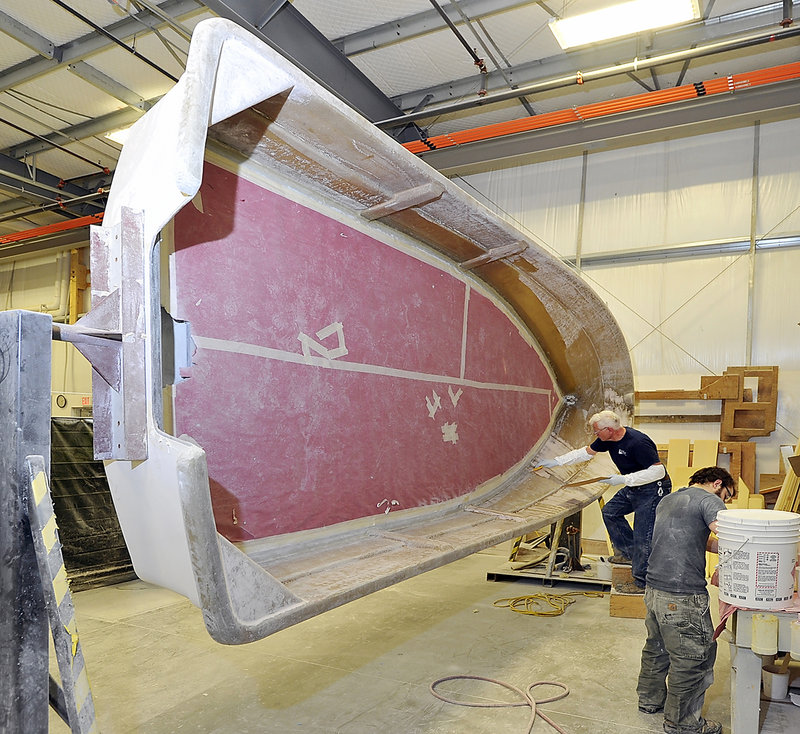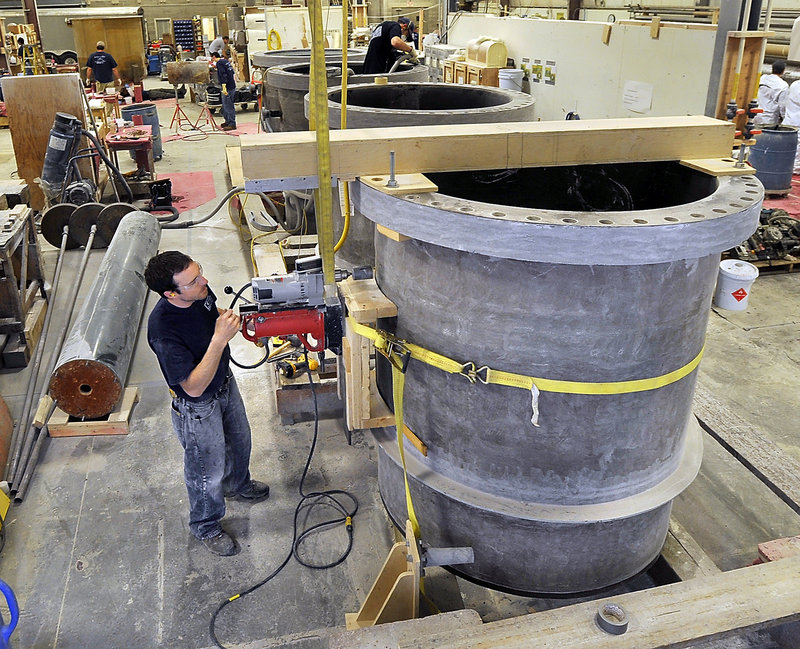AUGUSTA – Boats are sexy. Chemical storage tanks aren’t.
But both products play roles in the changing business strategy of Augusta-based Kenway Corp.
In recent years, the 64-year-old fiberglass manufacturing firm has entered new markets, like boatbuilding, bridge making and wind energy.
Diversification has helped Kenway grow when revenue from traditional clients, like paper and pulp companies, waned.
“There’s not a lot that’s fun and sexy about paper, pulp and tanks. But boats are fun,” said Kenneth Priest II, Kenway’s president, during a recent interview. “It’s all part of the plan to diversify.”
“(Kenway is) a poster child for what Maine companies have to do to survive and thrive,” said Steve Von Vogt, managing director of Portland-based Maine Composites Alliance. “They are doing things with infrastructure and pushing the edge on technology.”
Kenway, with revenue of $7.5 million and 70 staffers, is a “composites company,” said Priest. Kenway designs and manufactures industrial products made from fiberglass, like boats, blades, pipes, tanks and fittings.
Priest’s father, Kenneth G. Priest Sr., launched Kenway Boats, a wooden boat building company, in his Palermo garage in 1947.
In the 1950s, Priest Sr. switched to making boats from fiberglass, which is light and strong.
Soon, local pulp and paper companies asked Priest Sr. to build fiberglass storage tanks and pipes.
By the 1960s, Priest Sr. shifted entirely to higher-margin pulp and paper equipment and renamed the company Kenway Corp.
Kenway’s staff grew to eight in the late 1970s, including Priest II’s mother, Mildred, who was bookkeeper. Pulp and paper sales generated 80 percent of revenue.
Kenneth Priest Sr. retired around 1980, and left the company in the hands of his three sons. He died in 1981.
Priest II and his brothers decided to diversify when a paper company client canceled a large order in the late 1990s. They also moved Kenway to Augusta.
The odor of curing resin and epoxy hits you when you enter Kenway’s 40,000-square-foot production plant on Riverside Drive.
In the plant, workers in white, full-body coveralls used hand rollers to push resin as thick as molasses into fiberglass cloth. They were building a 20-foot composite pipe with a diameter of 4½ feet.
Priest said coal-fired power plants use the pipes to carry flue gas from boilers to scrubbers, where chemicals are removed from emissions.
In another area of the plant, two staffers, including Phil Mosher, head of product development, prepared to inject rectangular fiberglass panels with resin using “vacuum-infusion molding.”
They are developing a new Kenway product: fiberglass flooring for passenger rail cars.
The panels are vacuum-sealed in clear plastic bags, and a tube as wide as a broom handle leads from the bags to buckets of epoxy.
Mosher popped a clip, and resin, pulled by a vacuum, seeped into the panel.
BACK IN THE BOAT BUSINESS
Boatbuilding happens in the back half of Kenway’s production floor. There, employees apply glazing, polish gel coat, sand fiberglass and install battery wiring on boats in all stages of production.
Around the room sit fiberglass hulls, hull liners, center-console sections and giant molds, which workers use to build hulls.
Kenway re-entered the boat business in 2003, building sailboats and powerboats under contract for other companies.
One of those was New Hampshire-based Maritime Skiff, which made a value brand of 14- to 25-foot boats.
Kenway bought the company in 2007 and renamed it Maritime Marine. The boats are priced from $22,000 to $85,000.
In February 2011, Kenway purchased North Carolina-based Southport Boatworks, a company that launched in 2003 and built high-end 27- and 29-foot offshore recreational fishing boats.
When the recession hit, Southport shut down, its assets frozen.
Priest declined to discuss the purchase price, other than to say it was “ridiculously low.”
Since the purchase, Kenway has sold five boats, which start at about $160,000, and has deposits on three more.
Eric Smith, vice president at Southport dealer Smith Yacht Sales in Hingham, Mass., said a customer just placed a deposit to buy a 29-foot, “aqua mist” green Southport center console.
Smith said the boat, which has twin Yamaha 300 horsepower outboards and retails for roughly $206,000, arrived on his lot only three weeks ago.
“We are very happy with how the new boats have been constructed, and we have a lot of faith in Kenway based on all their years in the composites business,” said Smith.
Priest said the transition back to boat building went smoothly.
“We are using the same people to build pipes and tanks as we use to build boats,” he said.
Kenway now relies considerably less on paper and pulp companies — sales to the sector account for roughly 30 percent of revenue. Another 20 to 25 percent comes from sales to power companies, and 15 to 20 percent is from boat sales.
Kenway also builds wastewater treatment and aquaculture equipment (one client is the Center for Cooperative Aquaculture Research in Franklin), tanks used by college crew teams, water intakes for high-speed ferries and deck grab bars on the Navy’s DDG-1000 destroyer.
In addition, the company helped design culverts and the “bridge in a backpack,” a lightweight bridge that can be erected quickly.
MAINE ON CUTTING EDGE OF COMPOSITES
Diversification is happening across the composites industry, and some Maine companies are developing leading-edge products, said Von Vogt at the Maine Composites Alliance.
For instance, he said, Harbor Technologies LLC in Brunswick makes marine infrastructure products and composite bridge beams. And Pepin Associates Inc. in Greenville makes carbon-fiber products for the aerospace and other high-tech industries.
“Maine has a reputation, coming out of its great marine composite industry, for advanced, innovative uses of composites,” said Von Vogt.
Priest said Kenway’s revenue should hit $7.5 million in 2011, a 7 percent increase over last year. The company hired 10 new workers this year and plans to hire an additional five. The jobs are for engineers and fiberglass workers.
Mike Duguay, Augusta’s director of development, said Kenway’s diversification has allowed the company to shine at a difficult time. And he expressed excitement over the potential of Kenway’s wind-energy products.
“In the last seven years there has been a malaise in the economy, and they are one of very few companies that are growing, moving to the next step,” he said.
Duguay added that Priest “has seen where the industry is going in a clearer vision than most people.”
Priest owns Kenway with his brother Michael Priest, who works on the shop floor, and his son-in-law, Ian Kopp, Kenway’s general manager and vice president.
As for profits, Priest said, “we are making money.”
But boat sales are anything but certain; the industry has struggled in recent years.
LONG-TERM MARITIME FORECAST A POSITIVE ONE
In 2010, U.S. consumers bought 517,745 new recreational boats worth $5.9 billion, according to data from the National Marine Manufacturers Association. That’s down from the 572,520 boats consumers bought in 2009, worth $6.8 billion.
Thom Dammrich, the trade association’s president, said in a statement that positive economic trends indicate new boat sales will remain flat in 2011 and slowly recover in 2012.
Priest said production of the Maritime brand has declined by half since 2007, but added, “We are seeing more interest and more sales.”
He added, “If you can sell five Southports at close to 200 (thousand dollars) apiece, it adds up pretty quickly.”
Staff Writer Jonathan Hemmerdinger can be contacted at 791-6316 or at: jhemmerdinger@mainetoday.com
Send questions/comments to the editors.




Success. Please wait for the page to reload. If the page does not reload within 5 seconds, please refresh the page.
Enter your email and password to access comments.
Hi, to comment on stories you must . This profile is in addition to your subscription and website login.
Already have a commenting profile? .
Invalid username/password.
Please check your email to confirm and complete your registration.
Only subscribers are eligible to post comments. Please subscribe or login first for digital access. Here’s why.
Use the form below to reset your password. When you've submitted your account email, we will send an email with a reset code.